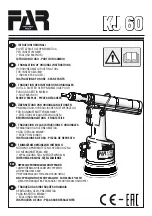
5 Gallon Siphon-Fed Abrasive Blaster
8
For technical questions call: 1-800-665-8685
8012660
V 3.02
work harder to maintain the pressure. Check at regular intervals and replace as appropriate.
2. Always check for cracks and leaks in the gun, hose, and plastic hopper bucket. These
problems must be fixed immediately due to the dangers involved with air under pressures.
3. Check for damaged parts. Before using any tool, any part that appears to be damaged should
be carefully checked to determine that it would operate properly and perform its intended
functions. Check for alignment and binding of moving parts, for broken parts or mounting
fixtures, or for any other condition that may affect proper operation.
4. Use only identical replacement parts or accessories intended for use with this tool when
servicing. Replace damaged parts immediately.
5. Keep the tool clean. Wipe the tool with a clean cloth and periodically blow out all areas with
compressed air. If compressed air is not available, use a brush to remove dust from areas.
Do not use harsh chemicals or solvents to clean the tool. These chemicals could seriously
damage the housing.
6. If repairs are required, bring your tool to Princess Auto Ltd.
PLUGGED CONDITIONS
All blasting systems are prone to plugging or wear because of the abrasive material used. The blast
nozzle may become plugged from moist media. Try dislodging the media with a drill bit held in your
hand. You need to discard the moist media.
WEAR CONDITIONS
This is usually noted when an excessive amount of dust appears while blasting. Dust will occur if:
1. The abrasive blasting media is worn out. If it has lost its granular or spherical appearance or
has a lot of debris mixed in from the parts being blasted, replace the abrasive blasting media.
This is usually noticed when the abrasive media that exits the nozzle resembles more of a
cloud than a stream.
2. The gun parts may wear out. This is usually evident when the blast pattern is too wide and
ineffective; simply replace the nozzle or orifice.
LUBRICATION
Do not use lubricants or air tool oil on the unit. The oil will contaminate the abrasive media, clogging
the tool and reducing the effectiveness of the abrasive.
DISPOSING OF THE TOOL
1. If your tool has become damaged beyond repair, do not throw it out. Take it to the
appropriate recycling facility.
2. Abrasive can be re-used until it eventually breaks down or becomes dusty. Dispose of waste
abrasives in accordance with local authority regulations.









































